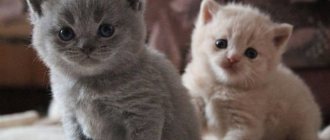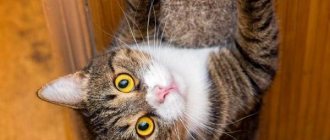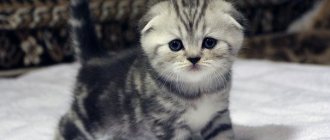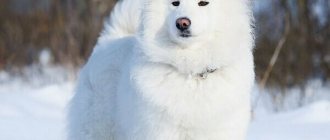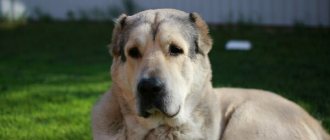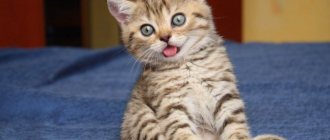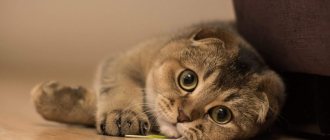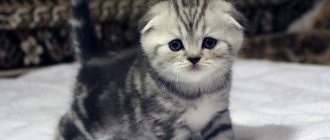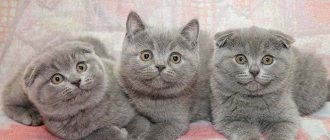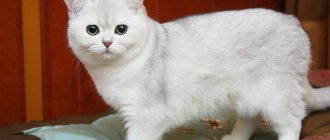A caring owner is always interested in whether his pet is developing correctly. In order to notice alarming trends in time, it is necessary to track the weight of the Scottish kitten by month.
It is important that the Scottish cat’s food is balanced and served in accordance with the regimen. Obesity not only spoils the pet's appearance, but is also dangerous to the animal's health in all aspects. Your Scottish Straight or Fold will live a long and happy life if treated well and with care.
Kitten at birth
Newborn “Scots” do not see, do not hear, and cannot regulate the temperature of their body. Babies have no undercoat - the hairs practically do not warm them. Kittens find it difficult to stand on their feet. Their bones are still very fragile, which is why it is important to treat the animal with care.
Scottish cats sleep all day, and during short periods of wakefulness they suck milk. Sleep is very important for them - at this time the nervous system continues to form. Babies cannot defecate - this process is stimulated by the mother cat, who cleans the “nest” of children’s excrement.
Kittens that have just been born already have a fairly developed sense of smell and touch - they quickly find their mother by smell and feel her nipples with their paws. Along with milk, the cat produces colostrum, which is rich in substances necessary for the formation of stable immunity in babies.
Human concern lies in two aspects: arranging a cozy corner for the cat family, balanced feeding of the mother. The owner changes the bedding and, if necessary, installs a heater or heating pad. Next to the “nest” he places bowls with water and food for the mother, her tray.
In the photo, video - a newborn Scottish:
This is interesting: Names for Scottish cats for girls
Care and maintenance of Scottish cats
Unlike many of their purebred counterparts, Scottish Straights are not demanding or needy to care for. But this does not mean that the lucky person who bought a Scottish kitten is forever freed from any responsibilities. As soon as the little playful creature crosses the threshold of the house, a new stage of life begins for its owner, associated with caring for a teddy cat bear. A straight-eared pet needs attentive and careful treatment and periodic health-improving and preventive measures.
- Grooming. It will take the most time to care for your cat's luxurious coat. Experts advise brushing fluffy cats once a week with a soft brush. Its natural pile should be moderately hard. Scots have a naturally smooth coat that does not tangle. Like other neat cats, Scottish cats keep their fur clean by licking it.
Due to the thick coating, the sensitive intestines may become blocked by a plug of cat hair. This usually leads to serious digestive problems. Therefore, veterinarians advise giving domestic kitties a special paste to remove hairballs.
Scottish cats are bathed as needed, no more than once a month, with the obligatory addition of specialized shampoos.
- Hygiene procedures. Obedient furry cats need their nails trimmed periodically. To do this, use scissors or tweezers. After a “manicure,” the owner should treat each finger with peroxide or a solution of potassium permanganate to prevent infection from entering the body.
The ears need to be cleaned with a cotton swab; this is usually done before bathing the cat. The large and radiant eyes of straights should be wiped with a damp cloth that does not contain “chemicals”.
With careful care, Scottish Straights can live 14-18 years.
Where to buy a straight-eared Scottish kitten
Little bundles can bring a lot of joy to your home. But it’s better to buy them not on Avito, but from certified Scottish straight-eared breeders. Kittens purchased from nurseries are prepared, have no diseases, are litter box trained and have a pedigree. But don’t forget to prepare yourself: purchase a tray, toy and food for the new family member in advance.
The price for a Scottish Straight kitten in Russia starts from 9,000 rubles
. Most of the cost of a kitten is determined by its color.
Breeding nurseries:
- Ermine Trace - Moscow
How to name a Scottish Straight kitten
Getting a kitten is half the battle; he still needs to come up with a name.
After all, the name of a pet is an important component of the life of both the animal and its owner. Straight-eared cats quickly get used to the nickname and respond to it. You can use the suggested nicknames for straight-eared Scots. Table of nicknames for straight-eared Scottish cats
| Girl | Boy | ||
| Abi Asya Buffy Blanca Bianca Waffle Vita Gadget Gretta Dymka Zora Toffee | Laima Mulya Nyuta Paprika Sandra Snezha Tara Toira Tori Fanya Chipa Sherry | Agate Aiko Ice Archie Barry Bars Belyash Vaigar Gizmo Gray Dick Zeus | Iris Cupcake Lex Magnus Murzik Oscar Ray Simba Troyan Fantik Hoshiko Shanti |
Breed health
Scots with straight ears are a breed with good health and reliable immunity. They will delight their households for a long time with their cute faces and kind, gentle disposition. Unlike their lop-eared relatives, they managed to avoid genetic abnormalities and dangerous diseases. However, Scottish Straights are recommended to visit the veterinarian's office several times a year to prevent illness. Owners should check the condition of their ears and teeth from time to time.
The first days of a kitten
In the first weeks, the young fluffy eats only mother's milk, and per day gains from 10 to 20 grams. So, if the weight after birth is known, then in the coming days you can estimate it with a certain accuracy without weighing.
At this time, babies are still blind, so they move little, staying close to the cat’s nipples. This circumstance contributes to the accumulation of mass, since the cub receives calories, but almost does not consume them. In addition, young creatures mainly sleep, so that by the time they are half-mooned they often weigh about 250 grams.
In order for the kittens to develop properly, the owner must be attentive to the optimality of the menu and the quality of the products that the mother cat eats. So you should purchase specially formulated food for her, and you should not set food restrictions for her.
By the half-month of life, babies have eyes. It is during this period that young fluffies begin to master movement on their own little paws. By this time, the baby’s weight can reach 420 grams. Just at this time, when kittens learn to walk, play and have fun, their appetite increases, so that their weight gain accelerates.
From the end of the third week, it is allowed to begin introducing the kittens to complementary foods a little at a time. But you should be aware that from the very beginning of complementary feeding this should be done using high-quality products.
The best choice would be specialized bagged food and canned food for kittens. It is not advisable to purchase cheap food, since it provokes the appearance of all kinds of diseases, for example, kidney stones.
note
Steady and constant growth is a key component in the proper development of a kitten. In the first days of life, still helpless kittens should, on average, gain about half an ounce of weight (15 grams) each day.
If they grow with such results, then we can assume that they are completely healthy. However, don't panic if your kitten stops gaining weight for a day or two. Quite often, kittens experience short-term weight stabilization, after which accelerated weight gain resumes.
https://www.purinaone.ru/cat/catmag/adoption-rescue/the-weight-of-the-kittens
https://petstime.ru/article/ves-kotenka-po-mesyacam-ot-rozhdeniya-do-goda
From 1 to 3 months
During the second month of life, Scottish kittens continue to actively gain weight, which during this period ranges from 400 to 1500 grams. The owner needs to remember that the pet’s gender directly affects its body weight.
If figures of 400-600 grams are normal for a cat, for a cat of 2 months this is considered underweight.
The third month is characterized by a decrease in growth rate; during this period, the pet’s body weight is approximately 1-2.5 kilograms.
Rules for caring for kittens
Basic care for Scottish Fold kittens for 2 months includes the following activities:
- Grooming. Depending on the thickness, use a comb with rare or frequent teeth. If the fur is tangled, use a special lotion and trim the tangles with scissors.
- Examination and cleaning of eyes. They are cleaned with a cotton swab dipped in water. Special drops are used after washing the eyes.
- Bathing. They teach it gradually from an early age, washing the cat once every three months.
- Ear cleaning. The procedure is done monthly two to three times. Using a cotton swab dipped in a special liquid, gently wipe the auricle.
- Nail trimming. Perform, if necessary, on the front paws, cutting off the very tip, no more than 2 mm.
- Teeth cleaning. For this purpose, special toothpastes and brushes are used. Regular brushing helps prevent dental plaque.
In addition, the kitten must undergo preventive treatment against helminths and be vaccinated against dangerous diseases.
Weight of an adult cat, kg
Abyssinian cat
3.4-6.1
American Bobtail cat
4.0-7.2
American Curl cat
3.1-5.5
American shorthair cat
3.8-6.9
American Wirehair cat
3.6-6.5
Angora cat
3.2-5.8
Balinese cat
3.1-5.5
Bengal cat
4.0-7.2
Burma cats
3.6-6.5
Bombay cat
3.6-6.5
British shorthair cat
3.0-6.8
Burmesian cat
3.1-5.5
Burmila cats
3.4-6.1
Havana Brown cats
3.2-5.8
Himalayan cat
3.8-6.8
Devon Rex cats
2.8-5.1
Egyptian Mau cat
3.0-5.4
Cymric cats
3.5-6.3
Cornish Rex cat
2.7-4.8
Korat cats
3.2-5.8
Manx cats
3.5-6.3
Munchkin cats
3.2-5.8
Maine Coon cats
5.8-10.5
Nibelung cats
2.5-4.5
Norwegian Forest Cat
3.2-5.8
Orientally cats
3.0-5.3
Ocicat cat
4.4-7.9
Persian cat
3.8-6.8
Russian blue cat
2.5-4.5
Ragdoll cats
5.0-9.0
Selkirk Rex
3.6-6.6
Siamese cat
3.1-5.5
Siberian cat
4.0-7.2
Singapura cat
2.5-4.5
Snowshoe cats
3.4-6.1
Somali cats
3.25.8
Sphynx cat
3.4-6.1
Tiffany cats
4.0-7.2
Slim cat
3.5-6.3
Turkish Angora cat
3.3-5.9
Turkish Van cat
4.0-7.2
Chartreuse cats
3.8-6.9
Scottish fold cat
3.0-7.2
Exotic shorthair cat
3.8-6.8
Javanese cat
2.8-5.1
Japanese bobtail cat
2.8-5.1
Track your pet's weight and make sure he grows up healthy!
| In our cattery you can “buy a real British kitten.” We have many different colors, we will help you choose and answer all your questions! |
Standards
The weight of a Scottish Straight individual is 3-3.5 kg, rarely more.
| Standard | Description |
| Head | The shape of the skull is round, with convex cheeks and forehead. The cheekbones are clearly defined (more so in cats than in cats), the chin is strong. The whisker pads are oval and plump. The nose is short, with a wide bridge and no noticeable stop. |
| Eyes | Large, widely spaced. The iris can be any color. |
| Ears | Large, wide at the base and with rounded tips. The outside is abundantly pubescent, the inside is less, but lush panicles, hard and long, grow on the skin. |
| Torso | Muscular, long, large, but with soft smooth lines. The neck is muscular and short. |
| Limbs | Long, strong, with oval and elastic legs. |
| Tail | Long, dense, reaching the shoulder blades in length. |
| Wool | The coat is thick, dense, and plush to the touch. It can be either short or medium length. Undercoat is present. |
Serious defects are considered:
- turned out toes;
- cryptorchidism;
- creases on the tail;
- short tail;
- small eyes;
- explicit “stop”;
- flat forehead;
- too wide ears.
General information about the constitution of the Scottish kitten
Breeders of Scottish and British kittens often like to monitor the process of their pet's weight gain. They carefully monitor how the Scottish kitten grows and changes in weight during the first year of life. This is important for the breed quality of the animal and subsequently determines its status.
How much does a Scottish cat weigh? The Scots are not particularly large in size; they are somewhat more graceful than their British “relatives”. Regardless of whether your breed is lop-eared or straight-eared, the weight standards for both breeds are the same.
The Scottish cat is a harmoniously built breed. Representatives of this breed are quite stocky and muscular, with a medium length and body weight. An adult Scotsman usually weighs between 5 and 7 kg. Weight also depends on gender. There are cases when representatives of this breed gain significantly more than the norm. Therefore, it is quite difficult to answer the question of how much a Scots cat should weigh.
This is interesting: Names and nicknames for Scottish Fold cats
Character of Scottish folds
While most cat breeds get used to their place of permanent residence, Scottish Folds, like dogs, also become attached to their owner.
This is explained by the fact that the breed was originally bred as a domestic dog. Fold cats have never lived in a semi-wild state, so attachment to humans is inherent in them at the genetic level.
The Scottish Fold can be kept perfectly in a city apartment. She is not drawn to walks in the fresh air, although they will not bother her. If the owners periodically take the Folds out to the dacha, they will not cause them any disturbance: the cat will stay close to the owner all the time, not trying to run away.
When buying a kitten of this breed, you should immediately understand that Scottish Folds are very attached to their owner and are very impressionable. Various unexpected changes may come as a shock to them:
- rearrangement of furniture in the apartment, which representatives of all cat breeds do not like;
- long absence of the owner;
- owner's inattention.
They experience loneliness very much, as well as physical pain. Because of this, they may become depressed. Small kittens and teenage cats are especially sensitive to human attention. They need daily positive communication with their owner, otherwise the animal may get sick.
Representatives of this breed have a calm and balanced character. Folds are distinguished by their patience and affectionate attitude towards people. Sometimes you can notice a certain phlegmatic nature in their character.
Aggressive behavior is not considered a breed trait. Scottish folds never clash, which is why some people consider them cowardly. In fact, this is a breed character trait.
Representatives of this breed are true gentlemen. They prefer not to notice the one who initiates the conflict. If a difficult situation arises, the Scottish Fold cat can always fight back the offender.
This breed is suitable for families with small children. Fold will never scratch a child if the baby pesters him and squeezes him in his hands. A cat of this breed will delicately try to move away from the child instead of fighting back.
Scottish Folds get along well with dogs and even rodents, although they will still have hunting instincts. At the most unexpected moment, this animal, which at times seems passive and slow, likes to stretch its legs. To do this, he needs to build a special “sports corner” where the Scottish Fold can stretch his muscles.
A feature of this breed is practicality, which is rarely seen in representatives of other cat breeds. Fold-eared individuals can distinguish information that comes to them from the outside world and use it to their advantage. This feature of mentality and character makes Scottish Folds highly trainable.
A characteristic feature of the breed, for which it is called voiceless, is the peculiar sound that the Scottish Fold makes. Their voice sounds more like a squeak than a traditional meow.
A Scottish Fold cat will decorate any home. She is distinguished by her beauty and grace. At a young age, all individuals are playful. Adult cats are sedate and calm, with a sense of real aristocracy.
Cats of this breed love to stand in a column position on their hind legs and sleep on their backs, which generates a lot of affection from all people. A muzzle with an owl's gaze leaves no one indifferent and gives a lot of positive emotions.
Cats of this breed fit perfectly into large families and become faithful companions to lonely people. Representatives of this breed especially appreciate the attention and care of a person, paying him in return with affection and love.
What to give?
After about 20 days of life, it is permissible for the kitten to introduce other complementary foods. Whether it's industrial feed or boiled beef/chicken, try to stick to one food line. If you don't have time to cook him a piece of meat every day or two, you will want to switch to dry food, but you need to do this gradually so that the kitten's body has time to adapt.
It is in the first months of life that a cat develops taste preferences, which he will adhere to. After a month, the kitten can be weaned from consuming milk alone. An adult cat does not live long on milk alone - it also needs other products.
In the very first days of complementary feeding, do not try to immediately give, in addition to meat (or food), several other products, such as: boiled egg yolk, black bread, broth. This is not an adult cat yet, and the kitten may have indigestion. A cat is not a person, he won’t be able to withstand such variety on the first day, he will simply vomit, act gradually.
If the goal is to diversify your Scottish kitten's diet, do not mix several foods in one meal. If a kitten develops a rash under its tail, then this is an allergy. By reacting in a timely manner, you will eliminate the product that caused it. In addition to the general rules of the diet, each animal has its own “unfavorite” product.
Raw yolk is given according to the same recommendations as milk and cream. As for industrial food, kittens that have just passed the age of one month need to be pre-soaked. After 1.5 months, that is, already at 2.5 months of age, they will learn to eat it in dry form, but do not forget about regularly adding fresh water to the “drinking bowl”.
Before the kittens are 3 months old, do not give them canned food or raw minced meat - the digestive processes do not immediately self-adjust for the absorption of such foods. After three months of age, a kitten’s diet approaches that of an adult cat. The mother cat should be protected: feeding kittens with natural cat milk too late can lead to exhaustion and early aging of her body. Everything is good in moderation, and experienced breeders are clearly aware of this.
Ready food
This type of feeding has many advantages. It is very comfortable. There is no need to waste time preparing food, worry about the diversity of the animal’s diet, or add supplements. This food is very tasty, and animals eat it with pleasure. You just need to make sure that they drink enough water. It is easy to accustom your pet to this food. Moreover, it is balanced. There are already all the components that an animal needs at one or another stage of life. The specialists made sure that the food was produced in accordance with all the rules.
But in addition to numerous advantages, this method of feeding animals also has disadvantages. First of all, this is the danger of fakes. There are a lot of them on the market today. The quality of such food, of course, is much lower. Even if the food is of the highest quality, it can be spoiled by improper storage. This is what often happens in modern stores.
There are several manufacturing companies that have proven themselves quite well. Veterinarians and breeders recommend purchasing their products for their pets.
- Royal Canin.
This company produces special food intended for kittens up to six months old. This is Babycat Instinctive. The food is a canned mousse. For this age, it is also recommended to gradually start giving the kitten dry food Kitten Instinctive 12. After the kitten is six months old, it is recommended to feed it with two types of food from this company. This is Kitten 34 - small pieces in gravy. Kittens really like them. The second type of food is Kitten 36. This is dry food. They should make up your pet’s diet for up to a year. After you open the bag of dry food, it must be sealed tightly. Otherwise, it may become damp and spoil. The canned food is transferred to a glass container, closed and placed in the refrigerator. - Innova EVO.
Ready-made food from this company contains few carbohydrates. Therefore, even if you overeat, the kitten will not gain weight. This dry food also contains a lot of calcium. All components here are natural. This includes poultry and a variety of vegetables. - Purina Pro products labeled Plan Dental Plus.
This food is designed specifically for small representatives of this breed. It not only ensures the supply of all necessary substances, but also helps maintain the Scottish Fold kitten's oral cavity in good condition. Research shows that cats who consume this food experience a significant reduction in dental plaque. - Hills.
This company's food contains a lot of carbohydrates. If the kitten tends to gain weight, it is better to give preference to another manufacturer. But, if the small pet is in good shape, such food will be very useful for him. After all, it contains calcium and magnesium.
What are the dangers of gross dietary violations?
Overfeeding can lead to premature wear and tear of the gastrointestinal tract, in particular to problems with the liver and pancreas. The same applies to the use of cheap, low-quality feed, since a cat is not a rooster, it cannot digest, for example, low-quality grain.
An attempt to transfer exotic cats raised on food to bones and other products from the human table will only bring negative results. Such an adventure often ends in the death of these animals - they flatly refuse to eat.
Tips from breeders on how to feed kittens correctly are presented in the video below.
Feeding dry food
This is very convenient, especially if you are a busy person
It is very important that before purchasing a pet you inquire about who Scottish kittens are, what to feed, how to care for them, and how to treat them in case of illness. If you choose ready-made food, you can save your time, and also be sure that your cat receives all the necessary minerals and vitamins.
However, keep in mind that ready-made food, both canned and dry, can only be given to adult animals. Therefore, up to a year, you will still have to cook for your baby yourself.
A very important nuance: you need to choose only high-quality food from trusted manufacturers, because the health of your pet depends on it. Products from the brands Ekanuba, Hills, Purina Pro Plan, and Royal Canin can be considered good. Cheap food like Kitty Kat should not be given. They contain by-products (bones, wool, feathers, skins) as sources of protein and a lot of dyes, flavors and mineral salts.
Recommendations for introducing complementary foods
For meat products, it is recommended to give preference to boiled or pre-frozen beef.
- Initially, you can put small pieces directly into the kitten’s mouth, and then gradually begin to accustom him to the plate. At 2.5 months, the pet should already be able to eat on its own.
- It is not recommended to give several different foods at once - this can lead to constipation. Also, if an animal develops an allergy, it will be difficult to determine what exactly. You can detect an allergic reaction by lifting the kitten's tail - there will be yellowish stains under it.
- The best source of calcium is cream with 10-15% fat content - it can be given 2 times a week in small portions from 4 weeks.
You should not feed your kitten canned food, purees, pasta or minced meat - these products have a negative effect on the digestive tract and can cause diarrhea.
At 1 year of age, you can stop monitoring your pet’s weight every month—after that, there won’t be much noticeable changes in your pet’s size or weight.
If the weight of a fold-eared cat is significantly lower than the specified minimum values, and tests do not reveal problems in the digestive tract, the doctor will help balance the diet and prescribe a vitamin complex.
If the Scottish Fold is visibly overweight, it is recommended to reduce the portions of the Scottish Fold's food and increase its physical activity - for this it is recommended to spend more time walking with the kitten. Obese pets increase the risk of diabetes mellitus and the development of problems in the cardiovascular system.
What should you primarily feed your Scotsman?
Before answering the question of what to feed a Scottish kitten for 4 months, it is worth studying its needs for daily intake of proteins, fats and carbohydrates, as well as microelements.
Indeed, in this case, the functioning of the digestive tract is disrupted and when switching to a more balanced diet, your baby may have problems digesting food.
shutterstock
Also, special attention should be paid to the fact that coarsely chopped food is still not allowed. List of foods that can be given to a 4-month-old Scottish kitten:
- finely chopped, well-boiled chicken, as well as veal;
- mainly sea fish, well boiled and boned;
- fermented milk products with low fat content and no more than once a day;
- various cereals mixed in a ratio of one to three with meat or fish;
- soups, with the exception of those that include potatoes, without large amounts of salt and spices;
- specialized food for Scottish kittens 4 months.
A prerequisite must be the availability of fresh, boiled water in constant access, regardless of whether you feed your baby with food or natural food.
Scottish cat size
The answer to the question of what size a Scottish cat or cat depends not only on their weight, but also on their body length. There are miniature cats that do not grow much in length, and therefore their body weight should be less. In general, Scottish cats are medium in size. The normal length of a Scottish cat (excluding the tail) is around 55 cm, give or take.
The height of Scottish cats, that is, the height from the floor to the withers, in a standing position on four legs, is approximately 30 cm. This is important to consider when choosing a carrier, because... The cat should be able to stand up to its full height in it without bending down. The same applies to the house tray.
If your cat competes at shows, then not only its overall size becomes important, but also the length of its tail and limbs. Ideally, the tip of the tail should reach the shoulder blades when laid along the body. The paws should not be too thick and short, like those of the British: let us remind you that the skeleton of the Scots is lighter and more graceful.
The body of the Scottish cat is from medium size to large, rectangular in format - not a square, with rounded lines, proportionate at the level of the shoulders and croup. A body that is too stretched or massive is considered a fault. Wide chest. The head is round like a ball, with pronounced whiskers (mustaches) and chin.
MORE ON THE TOPIC
Colors
Basic shades (solid):
- Black (a little white wool is allowed, but brown or red is considered a defect).
- White (with amber or copper eyes, or multi-colored eyes).
- Gray (without other color inclusions or patterns).
- Red (patterns on the paws and forehead are allowed).
- Chocolate (plain).
- Lavender (lilac, with a light brown nose and copper-colored eyes).
- Blue (blue: kittens may have patterns on their fur and copper eyes).
- Cream (possible patterns on tail and paws).
- Cinnamon (paw pads and nose - pale pink).
- Faun (eyes are bright, rich copper or amber, nose and paw pads are beige-pink).
- Bicolor colors - an admixture of white on the limbs, belly, chest or face. These are harlequin, van, ticked, shaded, tabby.
In the photo there are Scottish Straight cats of popular colors: black, white, blue
Rare colors: chinchilla, tabby, smoky, color point, calico, tortoiseshell (classic).
When choosing a pet for home keeping, color is not important, but in exhibition activities it is of no small importance. The CFA, for example, does not recognize chocolate, lilac, point, or all colors with white spots.
Animal health and size
In the first year of life, the owner of a Scottish kitten must carefully monitor how and how quickly he gains weight. Kittens weigh a little more than indicated in the table in the first weeks of life if there were few of them in the litter, and they receive a large amount of nutrients from their mother’s milk. The more kittens are born, the smaller their weight.
A kitten may be underweight if a nursing cat does not get enough calories from food. Another reason for lack of weight in the first week is the presence of congenital diseases and defects in the animal.
If a cat gains weight too quickly, this, like its lack, is considered a pathology. Too much weight is fraught with health problems. In obese animals, the risk of developing diabetes mellitus increases and there is an increased load on the heart muscle and vascular system.
If the causes of rapid weight gain are not identified and appropriate measures are not taken, the cat’s condition will only worsen with age.
If the weight is within the normal range, the “Scot” is active and mobile, this has the best effect on his formation and development. The musculoskeletal system is strengthened, internal organs work harmoniously.
Keeping body weight appropriate for age while maintaining proper nutrition is the best prevention of many diseases and guarantees a long life for the animal.
What does a kitten's weight depend on?
During the first two months of a kitten’s life, it is recommended to weigh it daily, and once a week after reaching two months of age. In this case, it is advisable to perform the procedure at the same time of day.
To monitor normal development, you can use the following table of a kitten’s weight by month. It is worth considering that an alarming signal is not only low, but also excessively high weight, which may indicate poor nutrition, a sedentary lifestyle, hormonal disorders and other problems.
The following factors influence the baby's weight:
- Breed. To control the weight of kittens by month for large breeds such as Savannah, Maine Coon or Ragdoll, special tables should be used.
- Floor. After several months of development, boys overtake girls in size and weight.
- Number of kittens in the litter.
- Balanced nutrition for cats during pregnancy and lactation.
- The presence in the kitten’s diet after switching to independent feeding of the entire complex of necessary vitamins, minerals and other substances.
- General health. Diseases and the presence of parasites can lead to developmental delays.
How to weigh
Determining the weight of a kitten at first glance seems somewhat complicated. However, everything is quite simple.
Methods:
- The first method is the most common, weighing on an electronic kitchen scale. Such scales show the result quite accurately, making weighing kittens from 0 months old very easy and simple.
- The second method also has the right to life. Here it is suggested to use commercial hand scales with a hook. To measure mass this way, you will need a bag or some other container to place the cat in. The container is pre-weighed separately. This method of measurement is far from the most accurate.
- The third method is more likely for adult animals whose weight is from 1 kg. You need floor scales on which you weigh yourself and then weigh yourself with your pet. The difference between the first and second weighing will be equal to the weight of the cat.
- The surest, but not the most convenient way, is to weigh the kitten in a veterinary clinic on special scales.
How to choose the right food for a 2 month old Scottish Fold kitten
Breeders advise feeding your pet the same food that its mother consumed. But if the new owners do not have the opportunity to buy expensive food, then the feed manufacturer and the type of product are selected individually. Carefully, giving a small amount of food, monitor the Scotsman’s condition. In the absence of negative effects, the feed is introduced for continuous use. It is especially necessary to ensure the compliance of all microelements and vitamins in it. When eating natural products, the daily diet is varied. The pet should receive lean meat, fresh sea fish, vegetables, cereals, and dairy products. You should not feed your Scotsman potatoes, legumes, onions, pork or lamb.
How to maintain body weight
To ensure the kitten’s full development and weight gain according to the established norms, it is necessary to take care of proper complementary feeding. It is recommended to introduce it from about 3 weeks.
From this point on, the cat's breast milk cannot fully provide a sufficient amount of calories, so the active growth of the animal may stop.
To maintain your pet's weight, new foods must be introduced correctly, following these guidelines:
- As the first “adult” food, a kitten can be given lean meat. Preference should be given to beef. The meat must be boiled or pre-frozen. First, you can put it in small pieces directly into the animal’s mouth. Gradually, the kitten needs to be taught to eat from a bowl. By 10 weeks the cat should be able to eat on his own.
- It is recommended to introduce new products one at a time. You cannot give 2 new ingredients at once on the same day. The digestive system will have a hard time coping with this. In addition, if an allergic reaction occurs, it will be difficult to understand which product triggered it.
- For normal growth of the kitten, calcium must be administered. Its source can be 10% fat cream. They can be given from the age of 1 month.
- During the period of introducing complementary foods, you need to carefully monitor the condition of your pet. Experts recommend periodically looking under the kitten’s tail. If yellow or brown streaks appear on the fur, this indicates the presence of an allergic reaction.
- You should not give your kitten canned food, minced meat or puree. They negatively affect the state of the digestive system. Many people believe that pureed foods are better accepted by the body. But such food can cause prolonged diarrhea. It is better to give harder food so that teeth develop faster.
A sudden change in diet can affect your pet's growth and development. Therefore, the owner of the kitten must choose in advance what he will feed it: natural products or commercial food.
Industrial products need to be selected according to the age of the kitten. It is important to purchase only high-quality feed that contains all the necessary vitamins and mineral elements that ensure the active growth and development of the animal.
To maintain body weight, muscle development, and growth, the kitten must be provided with sufficient physical activity. Regular games with your pet will help strengthen the musculoskeletal system and the proper development of internal organs.
If the cat’s weight begins to change up or down, this is a reason to immediately contact a veterinarian.
Catering
The issue of feeding should be approached with all seriousness: you cannot feed a living creature with just anything.
Food that is fatty, over-salted, with artificial preservatives and dyes in its composition will not bring any benefit to your pet, but it can “add” the stomach, liver, and other organs literally once or twice. And not all food from your table is suitable for an animal, even if it is good for you.
Natural products
Digestion is significantly different between humans and cats. The first thing a cat needs is calcium, phosphorus and taurine.
- And these substances can only be obtained from raw meat, lean and fresh: beef, chicken, rabbit, turkey, veal, lamb. During heat treatment, calcium transforms into a form that is practically not absorbed by the body, and taurine completely disintegrates. Meat components (muscle meat, offal, meat bones) should make up 90% of the daily diet.
- 5-10% are vegetables. Pumpkin, carrots, asparagus, zucchini, green beans, cauliflower, broccoli, greens (parsley, dill): vegetables are boiled or stewed and mixed with cereals. Cats rarely eat raw food.
- Rice, millet, oatmeal, buckwheat, semolina and pearl barley porridge are allowed. You can feed your cat with them every other day. Porridge is cooked in plain water without adding sugar, salt or seasonings.
- Chicken and quail eggs can be given no more than 2 times a week. Quails are boiled and fed whole; chicken ones are given only the yolk.
- Fish - flounder, hake, trout, salmon, tuna, navaga, saury, mackerel, ivashi, burbot, tench, chum salmon, carp - contains easily digestible protein, omega-3 and omega-6, and vitamins. But there is practically no calcium there, which causes problems with the musculoskeletal system in Scottish Straight cats. Therefore, fish can be given in small pieces along with meat and no more than once a week. Lack of fish will not negatively affect your cat's health if you add fish oil to the food.
- Low-fat fermented milk products - sour cream, yogurt, fermented baked milk, cream, cottage cheese, unsalted hard cheese - can be given every day, preferably in the afternoon.
- Vitamin-mineral complex, dry yeast in tablets, spirulina, kelp, sprouted alfalfa are very useful and should also be included in the diet.
Potatoes, legumes, cocoa-containing products, juices, alcohol, citrus fruits, bones, flour products and baked goods are prohibited!
Clean water at a comfortable temperature should always be available! You cannot give your animal water directly from the tap: tap water contains bleach and other components hazardous to the cat’s health.
Recommended food
From industrial feeds, choose only super-premium and holistic feeds. Go Natural, Savarra, Wellness CORE - these foods are recommended by both breeders and veterinarians.
Below are recommended super-premium foods. Links with the names of the food are clickable, on them you can, within our website, get acquainted with the descriptions of the food and read reviews from owners of cats of the Scottish Straight breed.
| Holistic | Super premium | Super premium |
| Wildcat | Golosi | Karmy |
Development table
The correct development of the Scottish Fold can be judged by the baby's weight gain. This is demonstrated by the weight table by month, based on standard indicators for the breed.
| Age (months) | Male weight (kg) | Female weight (kg) |
| 1 | 0,45-0,7 | 0,3-0,6 |
| 2 | 0,8-1,6 | 0,4-0,75 |
| 3 | 1,3-2,4 | 1,2-1,6 |
| 4 | 2-3,7 | 1,7-2,3 |
| 5 | 2,4-4,2 | 2,2-3,1 |
| 6 | 3-5,5 | 2,3-3,6 |
| 8 | 3,5-6 | 2,9-4,3 |
| 10 | 4,2-7,1 | 3,1-4,6 |
| 12 | 4,6-7,3 | 3,2-5,3 |
| 24 | 5,5-8 | 3,5-5,6 |
The physical development of a Scottish cat is completed by the 2nd year of life. The animal becomes massive and imposing. Kitties are more graceful, cats are more muscular.
When and how to bathe a 2 month old Scottish Fold kitten?
A small pet begins to be bathed only from the age of two months, and then only when it is heavily soiled or when fleas appear. Wash in warm water about 36 degrees with special shampoo. It is better to pour the water in advance, because the Scotsman is very frightened by its noise. It is advisable to put a rubber toy in the bath and water the animal from a ladle. The soap solution must be washed off thoroughly so that when licked, the product does not cause irritation.
Before bathing, oil drops are instilled into the pet's eyes to prevent irritation of the mucous membrane. Cotton swabs are inserted into the ears. After the water procedure, the baby’s fur is dried with a towel and a hairdryer at a distance of half a meter. Make sure your kitten doesn't catch a cold. The shampoo that the owners use is not suitable for the kitten; it will cause severe allergies.
How to feed little Scots
As mentioned above, the first feeding of Scots begins at three weeks of age. In order for a Scot to be healthy and gain the required weight, he needs to be well fed. The Scot will consume breast milk for up to 2-3 months, after which he must finally switch to a diet independent of the mother.
How and what to feed your Scottish baby:
- Starting from 3 weeks, you can give finely chopped (scraped) frozen or boiled beef. It must be placed in the baby’s mouth, it is better to start with once a day and gradually increase to three times. Around the end of the 4th week, they will be able to cope on their own without your help.
- You cannot give several new products at once (in one day). This will help track the moment if the kids develop allergies.
- Canned food, purees and minced meat should also be excluded. No matter how strange it may sound, in this form the products are not accepted by the stomach, so the nutrients will not reach their target. Moreover, the baby may have loose stools.
- You can start giving cream with 10% fat as early as a month. In order for the baby to drink them himself, you will have to help him. Dip your finger in the cream and touch it to your pet's nose. If he likes the taste, you can slightly push his face towards the saucer.
- Carry out regular inspection of your pets, namely, look under their tail. If there are yellow or brown stains on the fur, this indicates that the kitten is having an allergic reaction to something.
- Raw yolk is also a suitable complementary food. It should be given according to the principle of cream.
- If you want to feed your babies with specialized industrially produced food in the future, then it is best to start giving them from the age of one month. Naturally, in this case you do not give them natural food. Initially, the food will have to be soaked in warm water and lubricated with it on the baby's palate . So they will try it. After that, it is necessary to reduce the moisture content of the feed. Gradually, the kids will get used to it and will consume it in dry form.
- By 10 weeks, all babies should be able to eat and drink on their own. You should start taking care of your mother cat.
Diseases
The most common problems are:
- Discharge from the eyes. This is not necessarily a sign of an illness: it is often due to the specific structure of the skull and narrow tear ducts. If the discharge is clear or brown and odorless, there is nothing to worry about. But an admixture of yellow or red pus is a signal of a problem.
- Otitis, ear mites, fungus. If your pet constantly shakes its head and seems to be trying to get something out of its ear, take it to the vet. Maybe something got inside, maybe you scratched the delicate skin while cleaning, or maybe it’s due to the onset of a disease.
- Joint problems (eg osteochondrodysplasia). Over time, the bones become deformed, which is why the animal begins to experience difficulties when walking: it cannot fully straighten its paws, and it is difficult for it to jump.
- Urolithiasis disease. Castrated males are more likely to suffer from this disease. There may be several reasons: lack of vitamins, hormonal imbalance, severe cold, infection, poor diet. The animal begins to run around frequently, stops eating, becomes lethargic, licks itself frequently, and blood is visible in the urine.
- Excess body weight. Scottish Straight cats are prone to obesity, so their diet should be monitored especially carefully.
Expert opinion
Dusheba Vera Ivanovna
In 2010, she graduated from the Moscow State Academy of Veterinary Medicine named after K.I. Scriabin with honors, specializing in veterinary medicine. I regularly attend veterinary conferences, congresses, and webinars.
Whether or not to vaccinate your pet is up to each owner to decide for himself. But remember: you can bring pathogens into the house on your hands, clothes, and shoes. In this case, even thorough washing and disinfection of the premises may not save the animal from infection. Distemper, panleukopenia, calcivirosis, rabies are mortally dangerous and without vaccinations your beloved creature will face a painful death. In addition, without vaccinations you will not be able to take your cat abroad.
Feeding in the first year of life
Like kittens of other breeds, Scottish kittens consume only mother's milk up to 3 weeks. If an accident occurs, for example, a Scottish cat died during childbirth, from a malignant disease or due to accidental poisoning, or ran out onto the roadway, refused to feed the kittens, or other accidents, then orphaned kittens will benefit from milk formulas that are extremely close in composition to cat milk.
Good products are produced, for example, by Royal Canin, which specializes mainly in dog and cat food. Manufacturers of such products ensure that the fat content does not exceed 10%, and the vitamin content of the compositions is sufficient for the growing body of dogs and cats.
If there is no specialized store or veterinary hospital with a mini-store nearby where you can choose food for any kittens and puppies, act independently. To reduce the fat content, village (farm) milk is diluted in half with boiled water or cleared of cream and given to a newborn kitten to taste. They begin to feed it off, gradually reducing the number of meals per day from day to day, but increasing the volume of each complementary food.
You can take the nutrition of any average outbred kitten as a basis - all kittens consume approximately the same amount of milk. A specific breed - the same Scottish cats - requires its own amount of food in the first days and weeks of life, but you can save the life of your ward and let him grow up, adhering to the norm of “street” kittens.
The main thing is not to overfeed, not to underfeed, and not to forget about feeding regularly, otherwise the kitten will be late in gaining weight and will not develop properly, which will lead to illness and premature death later.
Sample menu by age
Here is a sample menu by age for Scottish Straight kittens:
Up to a month
Kittens up to 2-2.5 months receive all useful substances and antibodies from their mother’s milk and colostrum. This is the main food for kittens. But if a cat cannot feed her offspring, dies during childbirth, or does not have milk, breeders take care of the newborn kittens. Purchase the necessary food, tools and utensils for feeding orphaned kittens.
Industrial cat milk substitutes are used to feed artificial Scottish straight kittens. Their composition is similar to that of breast milk and contains all the necessary vitamins and nutrients for health, weight gain, and development.
Infant formulas with zero sugar content and no additives are also suitable for feeding Scots up to a month. But they are diluted with several times more water than the manufacturer indicated in the instructions.
But if you did not have time to purchase a substitute or special food, take 500 ml of homemade milk, dilute it half with water, add a teaspoon of sugar or 3 drops of glucose, one raw yolk. It is best to use goat's milk.
You can also prepare your own milk formula (Scott's formula, Tyling's formula for kittens).
Approximate calculation of portions:
- 1 week – 30-32 ml per 100 g of kitten’s weight;
- 2 weeks – 34-37 ml per 100 g of weight;
- 3 weeks – approximately 40 ml per 100 g of weight;
- 4 weeks – 48-53 ml per 100 g of kitten weight.
You can feed babies only with freshly prepared mixtures at room temperature. After eating, massage the base of the kittens' abdomen for several minutes to normalize metabolism.
Use a sterile cotton pad soaked in warm water to wipe the kitten’s genitals, since the first weeks of life the fluffies do not defecate on their own.
1 month
At 1 month, Scottish Straight kittens should receive milk nutrition. Scots can feed themselves starting from 7-8 weeks. At this age, complementary foods can be introduced.
When artificially fed, Scottish kittens continue to be fed with cat milk substitutes, milk formulas, and formulas for infants. Feeding frequency – 7-8 times a day.
2 months
At 2 months, Scottish kittens can already be given their first complementary foods. You can use special mousses, pates for kittens, fermented milk products (calcined cottage cheese, sour cream, fermented baked milk) for these purposes. All products are gradually introduced into the diet, constantly monitoring the condition of the pets and stool.
Gradually increase the serving size. Feeding frequency – 4-5 times a day.
3 months
At 3 months, Scottish kittens can be taken from the breeder. Before deciding on a diet, be sure to find out what the kitten ate and what the breeder used for complementary feeding. At first, the pet should receive the same nutrition. This will avoid problems with the gastrointestinal tract. Transition your kitten to a new diet gradually. Give new foods and feeds in small portions initially.
What is included in the Scottish diet:
- dairy, fermented milk products;
- mixtures, meat pates, canned food for kittens;
- raw, boiled minced meat;
- boiled chicken, turkey, veal, rabbit.
Soak dry granules in water, milk or kefir. It is best to feed your kitten semi-moist food if you plan to keep the animal on a prepared diet.
4 – 6 months
At 4-6 months, Scots already develop taste preferences and habits. They can be kept on a ready-made diet or natural food.
Vegetables, herbs, fruits, cereals, and lean fish are introduced into the natural diet. From six months you can give your Scots offal. Meat is the basis of the diet.
From 6 months to 1 year
From 6 months to a year, the Scottish Straight kitten's diet includes either natural, fresh, properly prepared foods or ready-made industrial food. The gastrointestinal tract at 6-7 months is almost completely formed. At the same time, the production of enzymes for the digestion of starch increases and the production of enzymes responsible for processing lactose decreases.
From 6 months to a year, the Scotsman is fed 2-3 times a day. Gradually increase portion sizes by decreasing the frequency of feedings.
From 6 months, kittens are given only fermented milk products. Whole milk can be completely excluded from your pet’s diet. With natural feeding, kittens are fed products that were listed in the “Natural Diet” section of this article.
Until one year, the kitten must be accustomed to a certain diet and diet.
Features of kitten growth
Representatives of both the Scottish and British breeds are distinguished by their large and muscular physique. Adult straight-eared and lop-eared individuals weigh between 5–7 kg.
Weight gain is especially noticeable in the first year of an animal’s life. Therefore, at this time the kitten should receive the optimal amount of nutrients and supplements (minerals, vitamins). A balanced diet will allow the kitten not only to develop properly, but also to maintain health at a high level.
Knowing how much a Scottish cat weighs at a given age can help you avoid a lot of problems. Therefore, it is important to track this indicator during the first year of your furry pet's life.
Origin story
The only significant difference between Scottish Straight cats and Scottish Fold cats is in the ears. They are not curved, but straight - that’s the whole difference. These cats appeared in the 60s of the last century on an ordinary Scottish farm, and initially the cats’ ears were folded. Breeders, having started breeding a new breed, quickly found out: in litters, both kittens with curled ears and normal ones are usually born, and in addition, the gene responsible for the lop-eared gene negatively affects the health of animals.
The cats' bones thickened, early osteochondrodysplasia appeared, and they died early. Through trial and error, it became clear: the best option for crossing is a cat with straight ears and a fold-eared cat.
The Scottish Straight breed was officially registered in 2004 and immediately became extremely popular.
A kitten not for breeding costs about 5,000 rubles (without documents) and 10,000 rubles with documents. Show-class specimens will cost 18-25 thousand rubles.
Tips for keeping your kitten healthy
Veterinarians recommend the following ways to maintain the health of a kitten:
- Study the movements and reactions of the kitten to immediately understand if he suddenly gets sick and immediately contact a veterinarian;
- Provide your kitten with proper nutrition by choosing a balanced diet appropriate for the animal’s age;
- Kittens need to sleep a lot, so provide your pet with a quiet and comfortable place to rest;
- Never wake a sleeping kitten;
- Take time to play with the kitten, as it needs communication and physical activity;
- Always stick to your vaccination schedule.
The first months of a kitten’s life are a time of intensive growth and development. By taking care of your pet's health at this stage, you can lay the foundation for a healthy kitten life in the future.
What to do if your weight is not normal
If underweight or overweight does not exceed 200 grams, then there is no reason to worry; most likely, the pet simply overate a little or did not move much. But if there is a large deviation from the norm, you need to contact a veterinarian, who will determine the cause and, if necessary, prescribe a course of treatment.
If your weight is below normal
If your Scottish Fold cat's weight at any stage of its growth is significantly below normal, you need to take your pet to a veterinarian. If the animal does not have problems with the gastrointestinal tract, the specialist will prescribe vitamins and give recommendations on changing the diet.
If your weight is higher than normal
Excess weight in a cat often causes the development of serious diseases, so the owner needs to monitor the diet and try not to overfeed the pet. If your pet is already overweight, you should review its diet and gradually reduce the portion size.
You will also have to take care of physical activity - you need to play with the cat more often to burn extra calories.
